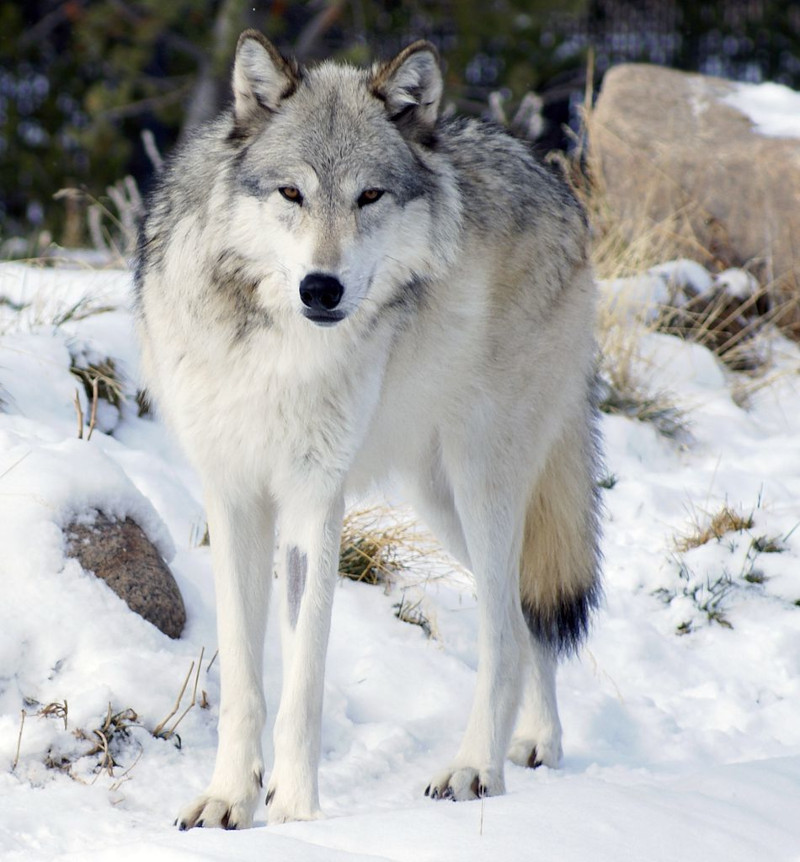Alaskan Timber Wolf Facts
- This majestic wild canine most frequently goes by the reasonably descriptive and informative common name of the Alaskan Timber Wolf. Yet, the canine also has several other, alternate common names. The variants typically occur across various parts of its native range.
- These other general titles include such terms as Nothwestern wolf, Mackenzie valley wolf, Rocky Mountain Wolf, and Canadian Timber Wolf. Professional researchers, however, tend to use the scientific name for it. That’s the hard to pronounce term Canis lupus occidentalis.
- The creature earned that name at the hands of the Scottish explorer and naturalist, Sir John Richardson. That noted individual accomplished the first official recognition of it as a separate and distinct species. He accomplished that scientifically noteworthy deed in the year 1829.
- Technically, this stunning product of evolution actually qualifies as a subspecies of the well-known Gray Wolf (Canis lupus). Regardless of which term one chooses to employ when discussing it, though, this work of Nature clearly stands out from the pack, so to speak.
- Fortunately, it appears to be maintaining a population base that’s both sizeable and stable. This trend further seems to hold true throughout the entirety of its natural range. The IUCN, therefore, presently has no liting for it on the organization’s Red List of Threatened Species.
- The wonderful Alaskan Timber Wolf nevertheless does faces several potential threats to its continued existence as a species, at least. Like all forms of life on earth today, the majority of those stem from the actions of man. They include the perils of habitat loss and climate change.
Related Articles
Alaskan Timber Wolf Physical Description
Although size isn’t the only impressive attribute of the gorgeous Alaskan Timber Wolf, by any means, it’s nonetheless among them. In point of fact, this marvelous work of Nature actually ranks as one of the largest of all known subspecies of the significantly better known Gray Wolf.
Like many mammals in the world, this marvel of evolution also displays a fairly moderate degree of the physiological trait of sexual dimorphism. In its specific case, though, this natural trait manifests itself in terms of pure physical size. That’s because males typically grow slightly larger.
Its sheer size also tends to vary across its entire range. Overall, however, certain patterns nonetheless predominate. Males typically range in weight from about 124 – 159 lb (56.25 – 72.1 kg). Females, meanwhile, average roughly 94 – 132 lb (42.6 – 59.9 kg) across the same range.
Both genders, however, despite the notable differences in weight, achieve roughly the same average height at the shoulder. This measurement ranges from about 26.8 – 36 in (68 – 91.4 cm). This, therefore, means that the males generally possess a slightly stockier build than the females.
In terms of general appearance, the two genders of the species achieve the same overall color pattern. That, though, varies widely among individuals, wholly regardless of gender. Individuals of the awesome Alaskan Timber Wolf all usually manifest long bushy tails, usually with a black tip.
The rest of the bodies of the mammal, however, display widely varied patterns of coloring. This design generally consists of random mixtures of various shades of gray and brown. Each also commonly displays light brownish-yellow markings appearing on both the faces and the undersides.
Variations in this natural pattern of shades and hues nevertheless do occur. When these do appear, they most commonly manifest in truly striking visual displays. These exceptional specimens sometimes possess such visually remarkable patterns as either pure white, brown, or pure black.
- Kingdom: Animalia
- Phylum: Chordata
- Class: Mammalia
- Order: Carnivora
- Order: Canidae
- Genus: C. lupus
- Species: C. l. occidentalis
Alaskan Timber Wolf Distribution, Habitat, and Ecology
Fortunately, the majestic Alaskan Timber Wolf inhabits a moderately broad swathe of the surface of the globe. That native range covers a respectabale portion of the continent of North America. This actually gives it a much more extensive range than the majority of its numerous relatives.
Understandably, as its most frequently used common name implies, part of that zone of habitation includes the state of Alaska, in the United States. But that’s only the beginning. That’s due to the surprising fact that, from there, that zone of habitation extends much further to the south.
That natural range additionally runs through much of the western provinces of Canada. The exception, though, is the prairie landscapes of the country. From there, however, the canine makes appearance across much of the northwestern portions of the continental United States.
Within that expansive range, though, the marvel displays an extraordinary adaptibility in its choice of habitats. That’s because it appears in such highly diverse regions as forests, tundra, prairie, grasslands, deserts, mountains, and grasslands. It even often appears in subarctic forest regions!
Like its many relatives around the world, the stunning Alaskan Timber Wolf evolved purely as a carnivore. It’s generally an active hunter, yet it does occasionally feed as an ambush predator. It also has a wide ranging diet, opportunistically including various creatures both large and small.
Its smaller prey frequently includes such species as ground squirrels, beavers, salmon, hare, voles, and lemmings. Yet it doesn’t hesitate to hunt prey roughly its own size, or even larger than itself. This even includes such prey as deer, mountain goats, sheep, moose, and even bison!
Species Sharing Its Range
Check out our other articles on 6 Laudably Luscious Lilies, Hyacinth Macaw, Macquarie island, Chinese Giant Salamander, Aye-aye, Mount Ranier Lousewort, Philippine Crocodile

